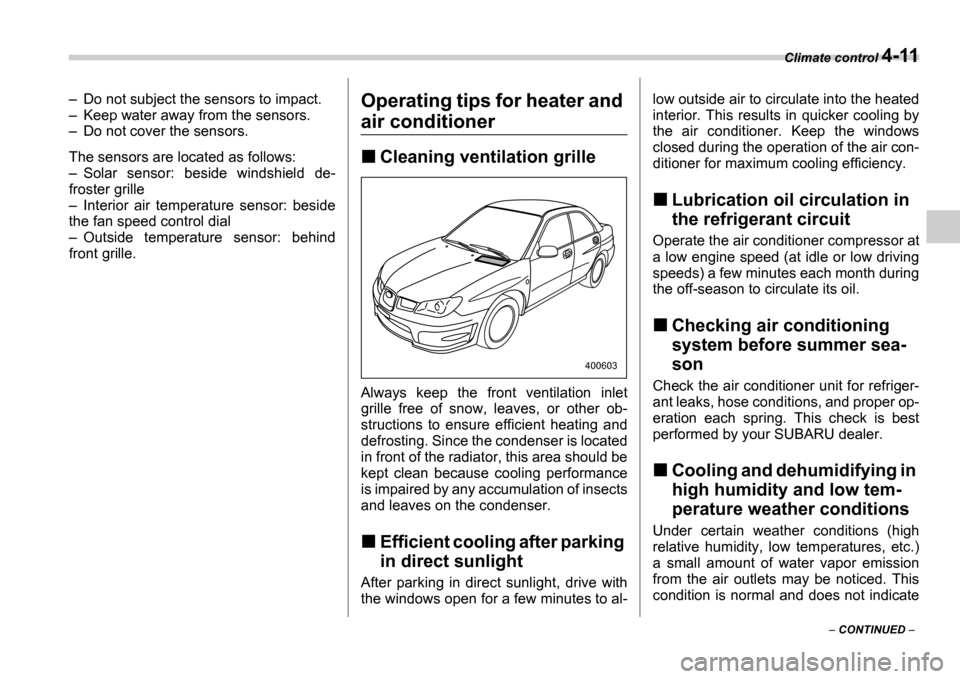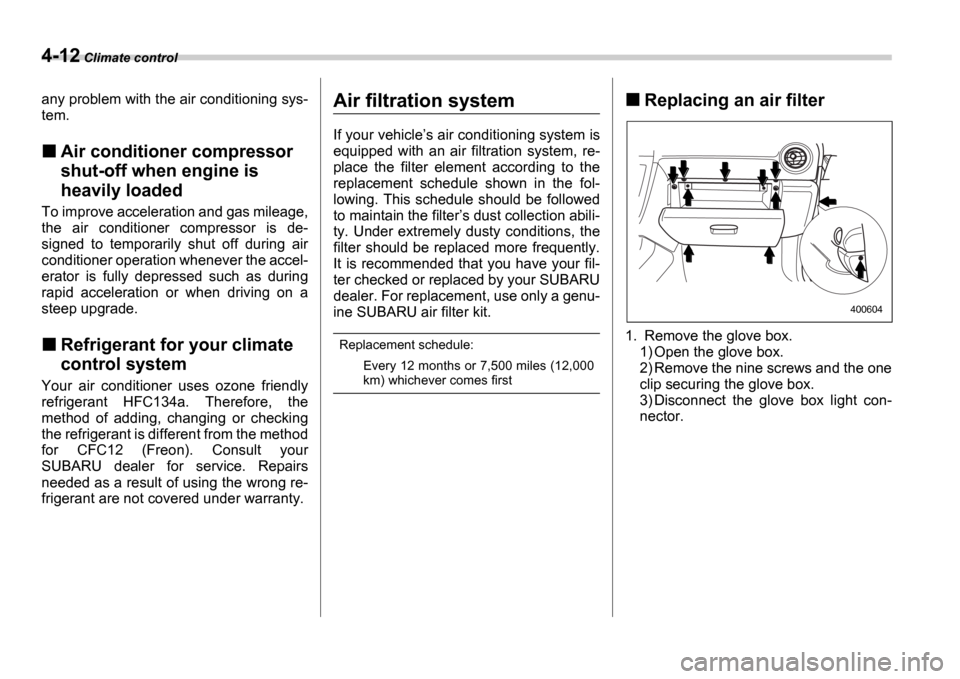2006 SUBARU IMPREZA air conditioning
[x] Cancel search: air conditioningPage 146 of 365

Instruments and controls 3-33
CONTINUED
cover the sensors with stickers, or other
similar items. Periodically wipe the sen-
sors clean using a piece of dry soft cotton
cloth or an applicator.
Compass calibration
1. For optimum calibration, switch off all
nonessential electrical accessories (rear
window defogger, heater/air conditioning
system, spotlight, etc.) and ensure all
doors are shut.
2. Drive to an open, level area away from
large metallic objects or structures and
make certain the ignition switch is in the ON position.
3. Press and hold the left button for 3 sec-
onds then release, and the compass will
enter the calibration mode. CAL and di-
rection will be displayed.
4. Drive slowly in a circle until CAL dis-
appears from the display (approximately
two or three circles). The compass is now
calibrated.
5. Further calibration may be necessary
should outside. Influences cause the mir-
ror to read inaccurately. You will know that
this has occurred if your compass begins
to read in only limited directions. Should
you encounter this situation, return to step
one of the above procedure and recali-
brate the mirror.
Compass zone adjustment
Compass calibration zones
1. The zone setting is factory preset to
Zone 8. Refer to the Compass calibration
zone map shown above or one attached
to the end of this manual to verify that the
compass zone setting is correct for your
geographical location.
2. Press and hold the right button for 3
seconds then release, and the word ZONE will briefly appear and then the
zone number will be displayed.
3. Press the right-hand button repeatedly
to cycle the display through all possible
zone settings. Stop cycling when the cor-
rect zone setting for your location is dis-
played.
4. Releasing the button for 3 seconds will exit the zone setting mode.
Outside mirrors
Convex mirror (passenger side)
10
9
8
7
6
5
4
3
1112
13
300580
Objects look smaller in a convex
mirror and farther away than when
viewed in a flat mirror. Do not use
the convex mirror to judge the dis-
tance of vehicles behind you when
changing lanes. Use the inside mir-
ror (or glance backwards) to deter-
mine the actual size and distance of
objects that you view in convex mir-
ror.
300146
Page 150 of 365

4
Climate control
Ventilator ............................................................. 4-2
Air flow selection ................................ .................... 4-2
Center and side ventilators ....................... ............. 4-3
Manual climate control system (if equipped) ..................................... ............... 4-3
Control panel ..................................... ..................... 4-3
Heater operation .................................. ................... 4-5
Air conditioner operation (if equipped) ........... ..... 4-7
Automatic climate control system (if equipped) ..................................... ............... 4-7
Control panel ..................................... ..................... 4-8
To use as full-automatic climate control
system ............................................ ....................... 4-8
To use as semi-automatic climate control system ............................................ ....................... 4-8
Fan speed control dial ............................ ............... 4-8
Temperature control dial .......................... .............. 4-9
Air flow control dial ............................. ................... 4-9
Air inlet selection button ........................ ................ 4-9
Air conditioner button ............................ ................ 4-10
Temperature sensors ............................... .............. 4-10
Operating tips for heater and air conditioner ....................................... ............... 4-11
Cleaning ventilation grille ....................... ............... 4-11
Efficient cooling after parking in direct sunlight .......................................... ....................... 4-11
Lubrication oil circulation in the refrigerant
circuit ........................................... ......................... 4-11Checking air conditioning system before
summer season ..................................... ............... 4-11
Cooling and dehumidifying in high humidity and
low temperature weather conditions ................ .. 4-11
Air conditioner compressor shut-off when engine is heavily loaded .......................... ............ 4-12
Refrigerant for your climate control system ....... . 4-12
Air filtration system ............................. ............... 4-12
Replacing an air filter ........................... .................. 4-12
Page 160 of 365

Climate control 4-11
CONTINUED
Do not subject the sensors to impact.
Keep water away from the sensors.
Do not cover the sensors.
The sensors are located as follows: Solar sensor: beside windshield de-
froster grille Interior air temperature sensor: beside
the fan speed control dial Outside temperature sensor: behind
front grille.
Operating tips for heater and
air conditioner
Cleaning ventilation grille
Always keep the front ventilation inlet
grille free of snow, leaves, or other ob-
structions to ensure efficient heating and
defrosting. Since the condenser is located
in front of the radiator, this area should be
kept clean because cooling performance
is impaired by any accumulation of insects
and leaves on the condenser.
Efficient cooling after parking
in direct sunlight
After parking in direct sunlight, drive with
the windows open for a few minutes to al- low outside air to circulate into the heated
interior. This results in quicker cooling by
the air conditioner. Keep the windows
closed during the operation of the air con-
ditioner for maximum cooling efficiency.
Lubrication oil circulation in
the refrigerant circuit
Operate the air conditioner compressor at
a low engine speed (at idle or low driving
speeds) a few minutes each month during
the off-season to circulate its oil.
Checking air conditioning
system before summer sea-
son
Check the air conditioner unit for refriger-
ant leaks, hose conditions, and proper op-
eration each spring. This check is best
performed by your SUBARU dealer.
Cooling and dehumidifying in
high humidity and low tem-
perature weather conditions
Under certain weather conditions (high
relative humidity, low temperatures, etc.)
a small amount of water vapor emission
from the air outlets may be noticed. This
condition is normal and does not indicate
400603
Page 161 of 365

4-12 Climate control
any problem with the air conditioning sys-
tem.
Air conditioner compressor
shut-off when engine is
heavily loaded
To improve acceleration and gas mileage,
the air conditioner compressor is de-
signed to temporarily shut off during air
conditioner operation whenever the accel-
erator is fully depressed such as during
rapid acceleration or when driving on a
steep upgrade.
Refrigerant for your climate
control system
Your air conditioner uses ozone friendly
refrigerant HFC134a. Therefore, the
method of adding, changing or checking
the refrigerant is different from the method
for CFC12 (Freon). Consult your
SUBARU dealer for service. Repairs
needed as a result of using the wrong re-
frigerant are not covered under warranty.
Air filtration system
If your vehicle s air conditioning system is
equipped with an air filtration system, re-
place the filter element according to the
replacement schedule shown in the fol-
lowing. This schedule should be followed
to maintain the filter s dust collection abili-
ty. Under extremely dusty conditions, the
filter should be replaced more frequently.
It is recommended that you have your fil-
ter checked or replaced by your SUBARU
dealer. For replacement, use only a genu-
ine SUBARU air filter kit.
Replacement schedule:
Every 12 months or 7,500 miles (12,000
km) whichever comes first
Replacing an air filter
1. Remove the glove box.1) Open the glove box.
2) Remove the nine screws and the one
clip securing the glove box.
3) Disconnect the glove box light con-
nector.
400604
Page 348 of 365

Consumer information and Reporting safety defects 13-7
CONTINUED
asymmetrical tire that has a particu-
lar side that must always face out-
ward when mounting on a vehicle.
Accessory weight
The combined weight (in excess of
those standard items which may be
replaced) of floor mats, leather seats
and cross bars to the extent that these
items are available as factory-in-
stalled equipment (whether installed
or not).
Curb weight
The weight of a motor vehicle with
standard equipment including the
maximum capacity of fuel, oil, and
coolant and air conditioning.
Maximum loaded vehicle weight
The sum of curb weight, accessory
weight, vehicle capacity weight and
production options weight.
Normal occupant weight
150 lbs (68 kg) times the number of
occupants (3 occupants).
Occupant distribution
Distribution of occupants in a vehicle,
2 in front, 1 in rear seat.
Production options weight
The combined weight of those in-
stalled regular production options weighing over 5.1 lbs (2.3 kg) in ex-
cess of those standards items which
they replace, not previously consid-
ered in curb weight or accessory
weight.
Vehicle capacity weight
The total weight of cargo, luggage
and occupants that can be added to
the vehicle.
Vehicle maximum load on a tire
Load on an individual tire that is deter-
mined by distributing to each axle its
share of the maximum loaded vehicle
weight and dividing by two.
Vehicle normal load on a tire
Load on an individual tire that is deter-
mined by distributing to each axle its
share of the curb weight, accessory
weight, and normal occupant weight
and dividing by two.
Tire care maintenance and
safety practices
Check on a daily basis that the tires
are free from serious damage, nails,
and stones. At the same time, check
the tires for abnormal wear.
Inspect the tire tread regularly and
replace the tires before their tread wear indicators become visible. When
a tire
s tread wear indicator becomes
visible, the tire is worn beyond the ac-
ceptable limit and must be replaced
immediately. With a tire in this condi-
tion, driving at even low speeds in wet
weather can cause the vehicle to hy-
droplane. Possible resulting loss of
vehicle control can lead to an acci-
dent.
To maximize the life of each tire and
ensure that the tires wear uniformly, it
is best to rotate the tires every 7,500
miles (12,500 km). Rotating the tires
involves switching the front and rear
tires on the right-hand side of the ve-
hicle and similarly switching the front
and rear tires on the left-hand side of
the vehicle. (Each tire must be kept on
its original side of the vehicle.) Re-
place any damaged or unevenly worn
tire at the time of rotation. After tire ro-
tation, adjust the tire pressures and
make sure the wheel nuts are correct-
ly tightened. A tightening torque spec-
ification and a tightening sequence
specification for the wheel nuts can be
found Flat tires section in chapter 9.